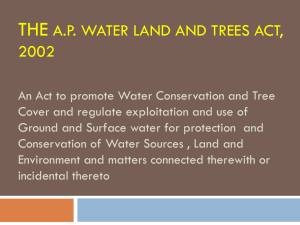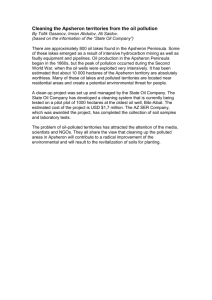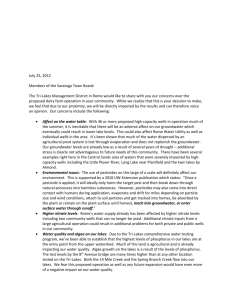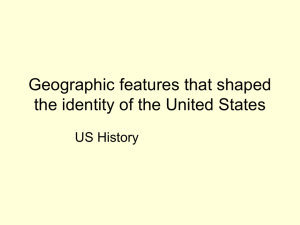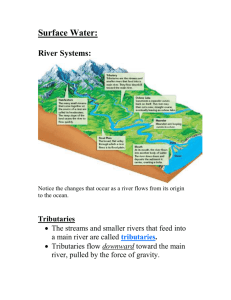Drained_Away_Lesson_-_Beth_Messman_8-09
advertisement
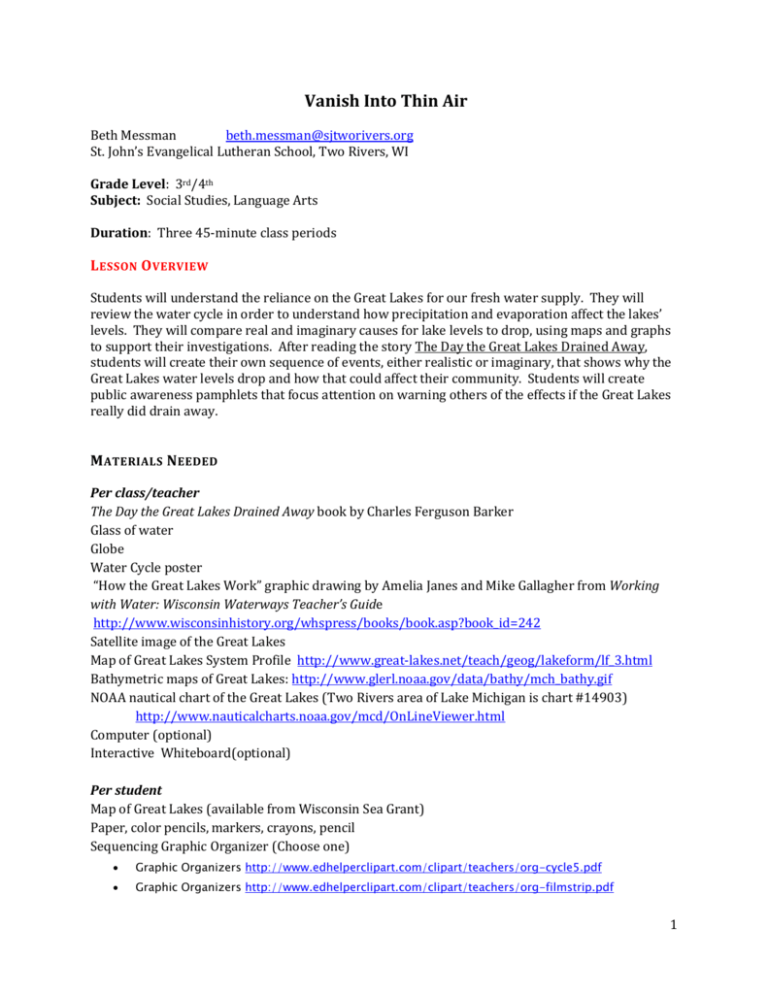
Vanish Into Thin Air Beth Messman beth.messman@sjtworivers.org St. John’s Evangelical Lutheran School, Two Rivers, WI Grade Level: 3rd/4th Subject: Social Studies, Language Arts Duration: Three 45-minute class periods L ESSON O VERVIEW Students will understand the reliance on the Great Lakes for our fresh water supply. They will review the water cycle in order to understand how precipitation and evaporation affect the lakes’ levels. They will compare real and imaginary causes for lake levels to drop, using maps and graphs to support their investigations. After reading the story The Day the Great Lakes Drained Away, students will create their own sequence of events, either realistic or imaginary, that shows why the Great Lakes water levels drop and how that could affect their community. Students will create public awareness pamphlets that focus attention on warning others of the effects if the Great Lakes really did drain away. M ATERIALS N EEDED Per class/teacher The Day the Great Lakes Drained Away book by Charles Ferguson Barker Glass of water Globe Water Cycle poster “How the Great Lakes Work” graphic drawing by Amelia Janes and Mike Gallagher from Working with Water: Wisconsin Waterways Teacher’s Guide http://www.wisconsinhistory.org/whspress/books/book.asp?book_id=242 Satellite image of the Great Lakes Map of Great Lakes System Profile http://www.great-lakes.net/teach/geog/lakeform/lf_3.html Bathymetric maps of Great Lakes: http://www.glerl.noaa.gov/data/bathy/mch_bathy.gif NOAA nautical chart of the Great Lakes (Two Rivers area of Lake Michigan is chart #14903) http://www.nauticalcharts.noaa.gov/mcd/OnLineViewer.html Computer (optional) Interactive Whiteboard(optional) Per student Map of Great Lakes (available from Wisconsin Sea Grant) Paper, color pencils, markers, crayons, pencil Sequencing Graphic Organizer (Choose one) Graphic Organizers http://www.edhelperclipart.com/clipart/teachers/org-cycle5.pdf Graphic Organizers http://www.edhelperclipart.com/clipart/teachers/org-filmstrip.pdf 1 Think/Pair/Share Graphic Organizer Think-Pair-Share http://www.educationoasis.com/curriculum/GO/GO_pdf/think_pair_share.pdf V OCABULARY At stake: in a position to be lost or won Crater: a hole made by an impact by a meteor Freighter: a large ship that carries cargo Trickle: to flow in a thin, slow stream Props: propellers which rotate and move a boat Ridge: a raised area of hills or mountains Artifact: simple object that represents a culture from long ago Yacht: small sailing ship used for cruising or racing Strait: a narrow channel connecting two large bodies of water Mussels: shell fish Glaciers: large body of ice that moves slowly down a slope or valley Locks: an enclosure with gates at each end that raise and lower boats Draw: to pull up or out Intake: a place where water is taken into something S UPPLEMENTAL C HILDREN ’ S L ITERATURE Just a Dream by Chris Van Allsburg Oil Spill by Melvin Burger Salmon Summer by Bruce McMillan L EARNING O BJECTIVES After this lesson, students will be able to 1. Make text-to-self, text-to-text, and text-to-world connections about the Great Lakes through the use of the story The Day the Great Lakes Drained Away and maps, graphs, and images of the Great Lakes. 2. Locate on a map the five Great Lakes, Lake St. Clair, Detroit River, St. Clair River, St. Mary’s River, Niagara River, and Niagara Falls. 2 3. Compare factual data from maps and graphs with imaginary information written and drawn in the story The Day the Great Lakes Drained Away to draw conclusions about the realistic and imaginary effects of the Great Lakes draining away. 4. Create a public awareness brochure on the importance of lake levels in the Great Lakes. 5. Show a sequence of events caused by the draining of the Great Lakes. WI A CADEMIC L EARNING S TANDARDS English Language Arts Standards Reading: Literature Grade3 and Grade 4 Key Ideas and Details RL3.1 Ask and answer questions to demonstrate understanding of a text, referring explicitly to the text as the basis for the answers. RL4.1 Refer to details and examples in a text when explaining what the text says explicitly and when drawing inferences from the text. Integration of Knowledge and Ideas RL3.7 Explain how specific aspects of a text’s illustrations contribute to what is conveyed by the words in a story (e.g., create mood, emphasize aspects of a character or setting). RL4.9 Compare and contrast the treatment of similar themes and topics (e.g., opposition of good and evil) and patterns of events (e.g., the quest) in stories, myths, and traditional literature from different cultures. Writing: Grade 3 and Grade 4 Text Types and Purposes W3.2 and W4.2 Write informative/explanatory texts to examine a topic and convey ideas and information clearly Research to Build and Present Knowledge W4.9 Draw evidence from literary or informational texts to support analysis, reflection, and research. Speaking and Listening: Grade 3 and Grade 4 SL3.1 and SL4.1 Engage effectively in a range of collaborative discussions (one-on-one, in groups, and teacher-led) with diverse partners on grade 3and grade 4 topics and texts, building on others’ ideas and expressing their own clearly. Language: Grade 3 and Grade 4 Knowledge of Language L3.3 and L4.3 Engage effectively in a range of collaborative discussions (one-on-one, in groups, and teacher-led) with diverse partners on grade 3and grade 4 topics and texts, building on others’ ideas and expressing their own clearly. Science Standards Science Connections 3 A4.2 When faced with a science-related problem, decide what evidence, models, or explanations previously studied can be used to better understand what is happening now Earth and Space Science E4.5 Describe the weather commonly found in Wisconsin in terms of clouds, temperature, humidity, and forms of precipitation, and the changes that occur over time, including seasonal changes E4.6 Using the science themes, find patterns and cycles in the earth's daily, yearly, and longterm changes Social Studies Standards Geography: People, Places, and Environments A4.2 Locate on a map or globe physical features such as continents, oceans, mountain ranges, and land forms, natural features as resources, flora, and fauna; and human features such as cities, states and national borders. A4.4 Describe and give examples of ways in which people interact with the physical environment, including use of land, location of communities, methods of construction, and design of shelters. A4.5 Use atlases, databases, grid systems, charts, graphs and maps to gather information about the local community, Wisconsin, the United States, and the world. A4.6 Identify and distinguish between predictable environmental changes, such as weather patterns and seasons, and unpredictable changes, such as floods and droughts, and describe the social and economic effects of these changes. A4.9 Give examples to show how scientific and technological knowledge has led to environmental changes, such as pollution prevention measures, air-conditioning, and solar heating. B ACKGROUND Students will have read fictional and nonfictional texts about how environmental issues affect their community: Just A Dream by Chris Van Allsburg, Oil Spill by Melvin Berger, Salmon Summer by Bruce McMillan. They will know how to read graphs and charts. Prior to this activity, students will have used maps to locate various bodies of water and land masses. Students will have already learned the geography of Wisconsin in social studies class. Students will have studied the water cycle in science class. Students will use this prior knowledge to assist them in the new activity. An excellent source of information about the Great Lakes, and specifically about their underwater features, depths, water surface area, and elevations is: http://www.great-lakes.net/teach/geog/intro/intro_1.html A DVANCE P REPARATION 4 Make a copy of the map of the Great Lakes for each student. The remaining maps, graphs, charts, drawings listed in materials may be shown using transparency, interactive whiteboard, or classroom computer. P ROCEDURE D AY O NE 1. FOCUS ACTIVITY: Display the glass of water. Activate prior knowledge by giving the students time for a Quick Write, answering the directive: List as many ways you can think of to empty this glass of water. The quick write should take no more than 2-3 minutes. 2. Have the students share their ideas with the class. No doubt there will be some imaginative ideas among the ordinary responses. (Drink it, sip it through a straw, pour it out, soak it out using a sponge, pump it out, use your fingers to flick it out, pound fist on table to make water “jump” out, wait for the water to evaporate, place the glass in the freezer and change the water to ice, etc.) 3. Use one of the suggestions to actually empty the glass. FOCUS QUESTION: Ask the class: “What would you do if you had been thirsty, and wanted a drink from this glass, but found out it was empty?” (Fill it up again and then take a drink.) Then tell the students that you will read a story about how so many people took water from the Great Lakes that the water drained away. 4. Read aloud The Day the Great Lakes Drained Away by Charles Ferguson Barker. Be sure to give time to observe the illustrations. Explain vocabulary as needed. 5. Ask students questions: What caused the lakes to drain away? (Millions of people “borrowed just a little water” with their “little pipes.”) What were some effects of this event? o Negative: The lake levels dropped. You couldn’t go sailing on the lakes. Niagara Falls disappeared and the tourists stopped visiting. Freighters were stuck in the muddy bottom. Ferryboats couldn’t take you across the lakes anymore. Stranded fish began to stink. Cities near the lakes could no longer get fresh water. People no longer could swim, fish, or vacation near the Great Lakes. o Positive: People could walk from port city to port city. You could see the land formations on the lake bottoms. You could drive across the lake bottoms. You could 5 find treasures from long ago at the bottom of the lakes. The Soo Locks were turned into a swimming pool. How were the Great Lakes saved? (People stopped taking water from the lakes, and the lakes filled up again. People became more careful about their use of the water.) Discuss briefly the water cycle, explaining how the lake levels rise and fall based on evaporation and precipitation amounts. You could also include a brief explanation of how storm surges and wet or dry seasons also affect lake levels. If all the Great Lakes dried up, would we still have a water cycle in our area? Why or why not? (Water cycle would still exist because of the rivers in our area, and also because of the oceans.) What does the water in the glass at the beginning of the lesson have to do with this story? (The water in the glass is like the Great Lakes. The glass will empty eventually, just as the lakes did in the story. We had to fill up the glass with water again. The lakes in the story did eventually fill up with water again.) 6. Conduct a Think-Pair-Share activity to encourage making connections. Tell the students to compare this story with one of the stories they read in their literature unit. (See list for examples.) The comparisons can be based on the characters, settings, problems, or solutions. THINK about how the two stories are alike or different. PAIR up with a buddy to discuss your thoughts. SHARE your best connections with the class. (Make a text-to-text connection.) This activity should take no more than five minutes. 7. Close this portion of the lesson by having students reflect in their journals. Teacher’s suggestions include: Tell how you would feel if this really happened to our Lake Michigan. How did the author show humor in this story? What part of the story made you think the most? Why? What could you do to stop the water from draining out of the Great Lakes? How did the illustrations enhance, or add to, the story? D AY T WO 1. Ask a student to point out the Great Lakes on the globe. 2. Hand out the Great Lakes maps and have pairs of students locate and name the lakes and rivers. Locate some of the cities and states mentioned in the story. Locate the city in which they live. Have students explore these map activities for as long as necessary to form a mental picture of the Great Lakes watershed. Help them to see the connection between the Great Lakes and the world in which they live. (Make text-to-world connection.) 3. Show the graphic drawing “How the Great Lakes Work.” This drawing gives a different view of the lakes, from an elevation point of view. Help students to find the highest lake (Superior), the lowest lake (Ontario), the connecting rivers (St. Mary’s River, Detroit River, St. Clair River, Niagara River, Niagara Falls) and the two lakes that are relatively the same elevation (Michigan and Huron). 6 4. Show students the profile map of the Great Lakes. This map shows the lakes from a side view. The students should easily understand the lake levels from this perspective. 5. Show students a satellite view of the Great Lakes. (Use any internet image that shows a clear view.) ** Optional: Show students the bathymetric map of Lake Michigan and the nautical chart #14903 as two more ways to indicate depth of the lakes. 6. Ask students to compare the resources they used: the globe, the map, the drawing, the profile diagram, the satellite image, bathymetric map, nautical chart Which resources helped you find where you live? Which resources show which lake is the deepest? Widest? Longest? Most shallow? Highest above sea level? Which resources could you use to answer these questions: o Which lakes are connected by rivers? o Which lake has the most coast line? o Which cities get their water from Lake Michigan? Continue with questions as interest allows. The idea is to help students see that using a variety of resources can give them a more complete picture of the Great Lakes. 7. Give students time to consider how changes to the water levels in the Great Lakes can impact the people who live near the lakes. Have students use their resources to help them consider the sequence of events that could occur if the Great Lakes drained away. This activity should make use of a Sequencing or Cycle Graphic Organizer. (Make text-to-self connections) D AY T HREE 1. Students work with a partner to create public awareness brochures. Students will make the brochures from the perspective of what their community might look like if the Great Lakes had drained away. (Cautionary Tale perspective) Brochure should include cautionary words and pictures that reflect the seriousness of the situation. The focus of the brochures can be realistic or imaginary. Students can refer to the story Just a Dream by Chris Van Allsburg. (In this story, a young boy doesn’t care about his environment until he dreams of a world filled with smog and pollution; void of trees and other beautiful scenery. When he wakes up, he takes positive action to insure that his dreams don’t become reality.) Students can create the brochures on paper using ordinary art materials. Or, Students can create brochures using computer programming. 2. Students may later share their brochures with students from other classrooms, their family members, and members of their neighborhood. 7 A SSESSMENT OF S TUDENT L EARNING 1. Use the reflection journals from day one to assess if students have a thorough understanding of the basic concepts found in the story. 2. Examine the sequencing activity from day two to determine if the sequence or cycle of events makes sense and is realistic. 3. Use a rubric specific to your class for the completed brochures from day three. E XTENSIONS 1. Have interested students re-examine the bathymetric maps and the nautical charts. Have students discuss why some portions of the lakes are shallower than others. Guided by the maps and charts, students can recreate the lake bottoms using clay and shoe box lids. 2. Students interested in speaking may create a radio public announcement warning of the impending catastrophe of the Great Lakes draining away, ending with a statement similar to Smokey the Bear’s “Only YOU can prevent forest fires.” S OURCES C ONSULTED Barker, Charles Ferguson. The Day the Great Lakes Drained Away. Mackinac Island Press, Inc., 2005. Berger, Melvin. Oil Spill. Houghton Mifflin Harcourt, 2006. Great Lakes Information Network. "How the Lakes Were Formed." 8 December 2004. teach.GLIN.net. 27 July 2011 <http://www.great-lakes.net/teach/geog/lakeform/lf_3.html>. —. "Introduction to the Great Lakes." 8 December 2004. teach.GLIN.net. 27 July 2011 <http://www.great-lakes.net/teach/geog/intro/intro_1.html>. —. "Water Levels on the Great Lakes." 8 December 2004. teach.GLIN.net. 27 July 2011 <http://www.great-lakes.net/teach/envt/levels/lev_1.html>. Malone, Bobbie, Jefferson J. Gray, Anika Fajardo. Working with Water: Wisconsin Waterways Teacher's Guide. Wisconsin Historical Society Press, 2001. McMillan, Bruce. Salmon Summer. Houghton Mifflin, 1998. National Oceanic and Atmospheric Administration. "NOAA Nautical Chart On-Line Viewer." September 2008. Nautical Charts and Pubs. 27 July 2011 <http://www.charts.noaa.gov/OnLineViewer/14903.shtml>. National Oceanic and Atmospheric Administration. Great Lakes Environmental Research Laboratory. 27 July 2011 <http://www.glerl.noaa.gov/data/bathy/mch_bathy.gif>. Van Allsburg, Chris. Just a Dream. Houghton Mifflin, 1990. 8


